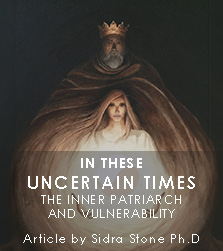| Relevent Links Books |
| Partnering |
| The Shadow King |
When the selves involved in the bonding pattern are protective, nurturing parents and children who need care or who truly appreciate a caring parent, this can feel comfortable and quite safe. Then we call it a positive bonding pattern.
This doesn’t mean it is good, it just means it feels pretty good. This default position - like the default setting on your computer - works. But it severely limits your choices in life and it just doesn’t give you, or the other person, the chance to be all that you can be! But the worst of all is that this positive bonding pattern almost invariably leads to a negative bonding pattern. Everyone knows what that is like; it feels terrible, and when you try to do to fix it, either nothing changes or you find you have made matters worse. We will talk more about negative bonding patterns next time.
As a matter of fact, the selves you like best in others and want to keep around (like the responsible ones, the caretakers, or the indulgent ones) might actually not be very good for you - just like too many sweets. These selves in the other person can become like parents to you. And, when they do, you are likely to lose the ability to care for yourself. This creates real vulnerability in you and an unstable situation of deep dependence. At the same time, it usually creates a feeling of being responsible for the other person.
What Happens in the Positive Bonding Pattern?
You are severely limited. There are only parental and child selves available to you in this positive bonding pattern. Think of it as though you have taken your partner’s (or friend’s or co-worker’s) Inner Child onto your lap and have promised to care for it. Conversely, your partner (or friend or co-worker) has taken your Inner Child into his/her lap and is taking care of it. Neither of you has access to your own child, only to the others’. This has a good side and a bad side. The good side is that you protect, love, and care for one another. The bad side is that you forget how to take care of yourself and become totally dependent upon – and, at some level, responsible for - the other person.
There are other difficulties. You cannot risk disrupting the delicate balance, so you don’t do or say anything that might upset the other person. There is less and less to talk about. More and more of your emotional reactions go underground and begin to become silent judgments. And - perhaps worst of all - you forget who you are and what is important to you.
How Can Your Recognize a Positive Bonding Pattern?
- The relationship feels “airless” – not necessarily suffocating - but airless as though you were in a room in which all the windows have been closed for some time.
- The relationship becomes less spontaneous. Everything seems predictable.
- The sexuality has disappeared, diminished, or lost its passion and become just a part of the daily duties.
- You usually feel strong, more able to ake care of the really important matters, quite competent and – with understanding and affection - you see the more childish qualities and the needs of your partner.
- There is less and less to talk about and there are more and more topics to avoid.
- You find that you are arranging your life to accommodate the other person.
- You can’t remember your own preferences; you have trouble remembering what gives you pleasure - what it is you really like to do.
- You have forgotten what it is that your partner does – or did - that upsets you.
- You don’t share your reactions or feelings – if you do feel them - because you fear that they will hurt the other person, or that they might disrupt a perfectly good relationship.
- You don’t feel entitled to want something or feel a feeling if it might disrupt the relationship.
- You find yourself being attracted to - or having fantasies of romance with - people outside of your relationship.
To learn more about bonding patterns - both positive and negative - and how to deal with them, we invite you to print out and read the article Making Relationships Work for You on this website. For more information, see our books, Partnering and Embracing Each Other.
An Introduction to Voice Dialogue, Relationship, and the Psychology of Selves gives an in-depth, complete, and clear introduction to the bonding patterns in a set of 2 CDs. Partnering: The Art Of Conscious Relationship is a set of 10 CDs recorded live that includes our most recent presentation on this topic.
![]()






